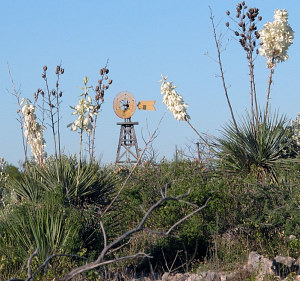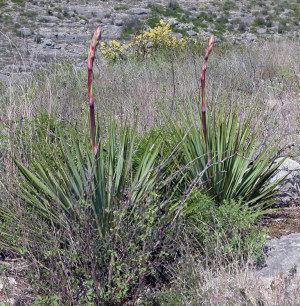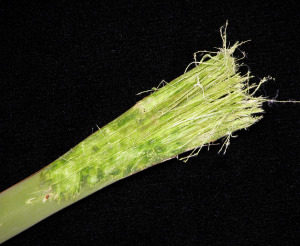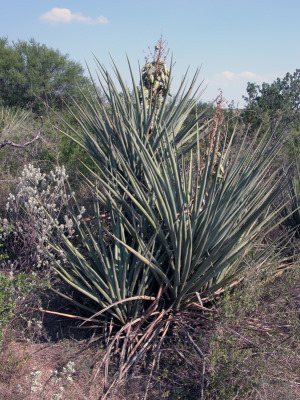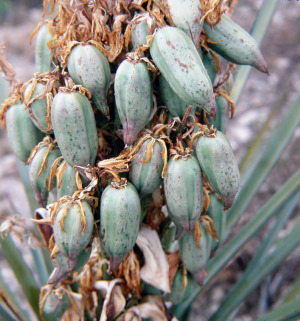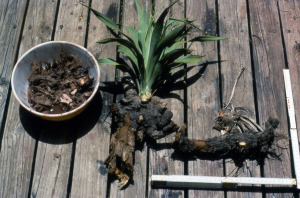Yucca
Yucca spp.
Liliaceae (Lily Family)
Two types of yucca plants grow in the Lower Pecos Canyonlands, thick-leaved (or fleshy) yuccas and thin-leaved yuccas. There are several species of each type in or near the region. The leaves of all of the region’s yuccas have strong fibers suitable for weaving and other uses, and the stems of most species can be used for soap. Yucca flowers and flower stalks are edible. The thick-leaved yuccas have edible fruits. Like the agaves, the yuccas store carbohydrates in their stems and leaf bases, but we lack convincing evidence that yucca stems were baked in earth ovens and eaten in a similar fashion as lechuguilla and sotol. Based on current knowledge, yuccas were at least a minor food source in the region and an important source of weaving and sewing materials as well as soapy compounds.
Three species of thin-leaved yuccas growing in the area include: Buckley’s yucca (Yucca constricta), narrow-leaf yucca (Yucca reverchonii), and Thompson’s yucca (Yucca thompsonii). They produce a dry, inedible fruit, but the leaves can be used for weaving and the stems for soap.
Edible yucca fruits come from the fleshy-leaved yuccas. The best documented of these is the banana yucca, Yucca baccata. Its distribution is centered west of the Edwards Plateau in the Sonoran and Chihuahuan Deserts. Although banana yucca specimens have been collected from extreme northwestern Val Verde County, the most common of the edible yuccas in the study area is Torrey yucca, Yucca torreyi. Although to the uninitiated the Torrey yucca vaguely resembles the banana yucca, the fruits are about one-half the size of the robust banana yucca fruit.
Archeological occurrence. San Angleo yucca, similar to Buckley yucca, was common in the trash deposits in Baker Cave, on the Devils River (Brown 1991). In all of the rockshelters in the Lower Pecos, where the preservation of plant materials is astonishingly good, both yucca leaves and yucca seeds occur by the thousands (Dering 1979, 1999; Irving 1966). Some dried human coprolites (feces) collected from Hinds Cave were loaded with pollen providing evidence that the ancient inhabitants ate yucca flowers. We can infer this behavior because yucca pollen is never released into the air; in order for large quantities of pollen to be recovered someone had to be eating the flowers (Williams-Dean 1978). Sandals as well as many other implements such as traps, snares, and basketry, collected from well-preserved rockshelter sites in the Lower Pecos region, have yucca components (Andrews and Adovasio 1980).
Food. Most of the yucca species found in the Lower Pecos Canyonlands do not grow in the regions with ethnographic records. However, there are accounts of the use of many related species elsewhere in North America. For instance, Willis Bell and Edward Castetter (1941:18) noted that the Apache in New Mexico, who ranged from the upper Rio Grande eastward to the area around Uvalde, had many uses for yucca. It is likely that they used the yuccas of southwestern Texas in similar ways to they used the closely related yuccas in their western range. The stems, leaf bases, flowers, emerging flower stalks, and fruits of many yuccas in the Greater Southwest were edible when harvested and processed properly.
Emerging flower stalks were collected "just as they came into bloom", roasted on coals (Castetter and Opler 1936:38). My own experience is that the flower stalks have to be removed within a few days after they emerge and long before they bloom, or they become far too fibrous and tasteless to eat, even after baking them. The flower stalks of narrow-leaf yuccas are edible raw, but it's best to eat the portion just below the leaf-like bracts, because they can be a bit prickly. Baking the stalks helps to soften any prickles. By the time the flower buds are visible, the sugar has been expended and the stalk is about as palatable as manila rope. The figure at right shows edible flower stalks that have been picked long before the flowers begin to emerge. They resemble large versions of asparagus.
The flowers of many yucca species are edible. Most native informants emphasize that the flowers had to be picked "at the right time". This is clearly the case, as yucca flowers can either grace a salad or ruin it, depending on how soon the harvester got to the plant after it began to bloom, and which plant one picks. Taste them before you bother to take them home. The Apache preferred the flowers of Yucca elata, a thin-leaf yucca, to those of the thick-leaf banana yucca (Bell and Castetter 1941:19).
Use of the fruits of the w idespread banana yucca or datil, Yucca baccata, is well-documented, having a distribution that stretches from western Texas throughout northern reaches of the Chihuahuan and Sonoran Deserts. Most groups within its range harvested the fruits, then roasted or baked them. The resulting product is brown and sweet, tasting much like molasses or figs.
After baking, most groups continued the process by stripping the seeds and pounding the remaining flesh of the baked fruit into a pulp. They shaped the pulp into flatcakes, and sun-dried them. The sun dried cakes could be stored or ground into a powder for mixing with other foods. Some groups, like the Gila Pima, boiled the fruit, dried it, and pounded it into a sweet meal (Russell 1908).
People were not alone in their appreciation of yucca fruit. Competition with animals was so fierce that several Native American groups harvested the fruits before they ripened. The Yavapai ripened the fruits by burying them under a mound of earth or soaking them in water (Gifford 1932).The Mescalero and Chiricahua Apache collected the fruits before they were fully ripe, placed them on bluestem grass, and covered them with grass in full sunlight so that the warmth would continue the ripening process. They roasted the fruit on hot coals, removed the blackened skin, and split it to remove the strips of seeds inside. The remainder was pounded into flatcakes and spread on animal hide to dry in the sun. The sweet juice drained from the fruits while being pounded and shaped into cakes was usually consumed or poured over the cakes. Dried cakes would keep for a very long time (Castetter and Opler 1936:39). Other groups that utilized the banana yucca fruit include Havasupai, Hopi, Navajo, Pima, Yavapai, and Zuni.
In addition to historical/ethnographic accounts, we have some recent experimental information on yucca fruit. Neal Stilley has conducted several experiments cooking both banana yucca and Spanish dagger (Yucca treculeana). He found that banana yucca is not a only larger fruit, but also a much tastier fruit. Despite its bland taste, the Spanish dagger fruit is quite edible and would have provided an excellent source of carbohydrates. When baked and dried, the fruit of both species will keep for several months.
Stems or trunks of the thin-leaf yuccas were harvested and eaten by several native groups. Like the agaves, the yuccas store carbohydrates linked to steroids in a class of chemicals called saponins -- a toxic, soapy compound. To render yucca stems edible, saponins must be broken down by baking the stem in an earth oven. Castetter and Opler (1936:38-39) describe the preparation of soaptree (Yucca elata), a thin-leaf, tree-like yucca that grows throughout the Southwest.
The crowns of this species were gathered any time from the middle of March to the end of summer, the portion of the stem from the ground to the leaves being peeled and baked overnight in an underground oven. . . .
The authors are describing baking the "trunk" of this tall yucca, and I have tried this with a smaller species only to find that the trunk portion is too dry and fibrous for eating. However the upper portion of the trunk encased in leaves it still somewhat edible, if a bit soapy. The inner leaves, those just emerging within the central portion of the rosette, are edible after boiling with other foods or alone.
Medicine. Yucca fruit are not only sweet, they are, like agaves, a very strong laxative (Colton 1974; Palmer 1871). A large plate of this tasty treat will keep you running like the Eveready bunny, so to speak. Many other parts of the yucca were concocted into laxative potions. The Kiowa treated a number of skin problems with yucca sap (Vestal and Schultes 1939). The Lakota used an infusion of yucca roots to treat vermin-infested hair (Rogers 1980). The western Apache shaman used the flower stalk of soaptree in healing activities, shaping it like a snake, chewing it up, and spitting on the patient (Buskirk 1986).
Soap. Yucca is an excellent source of soap or detergent. Many native groups used yucca as soap for bathing, and for washing clothing, hair, and any thing else that needed cleaning. Like the agaves, the yuccas store carbohydrates linked to steroids in a class of chemicals called saponins. When the central stems or rhizomes of some yuccas are pounded and soaked in water, the resultant mix will foam. Of the yuccas growing in the Lower Pecos Canyonlands, Torrey yucca provides the best source of this natural detergent.
Fiber. Torrey yucca leaves contain a long straight fiber that is much finer than the Agave lechuguilla fiber, and provided material for baskets, fine cordage, and perhaps even the paintbrushes that were used to paint the murals on the canyon walls. The entire leaf of the thin-leaved yuccas has been used to weave mats in a manner similar to the mats woven with sotol leaves. The Papago used the leaves or the fiber from the leaves to weave mats or to tie basket coils. They also used the leaves to attach material to house frames (Castetter and Underhill 1935:54). The Cahuilla used yucca to make sandals and nets (Bean and Saubel 1972). Recognizing the effectiveness of saponins as a hemolytic compound, the Ramah Navajo used the sap from leaves as arrow-tip poison (Vestal 1952).
Ritual. Yucca played an interesting, perhaps even significant role in Zuni ceremonialism. Participants taking on the persona of anthropic (human-like) gods carried yucca flower stalks in both hands. They used the flower stalks to whip certain individuals, including patients asking to be relieved of bad dreams, or other participants who were drifting off to sleep during the ceremony. Some "personators" of anthropic gods also wore a yucca leaf wrapped around their heads, and the observer took pains to emphasize that the yucca band was not visible to the spectator. They also wore yucca ribbons around their ankles and wrists (Stevenson 1915:99; 1904:130).
References:
Andrews, Rhonda L. and James M. Adovasio
1980 Perishable Industries from Hinds Cave, Val Verde County, Texas. Ethnology Monographs Number 5. Department of Anthropology, University of Pittsburgh. Pittsburgh, Pennsylvania.
Bean, Lowell J. and Katherine S. Saubel
1972 Temalpakh: Cahuilla Indian Knowledge and Usage of Plants. Malki Museum Press. Morongo Indian Reservation, Banning, California.
Bell, Willis H. and Edward F. Castetter
1941 The Utilization of Yucca, Sotol, and Beargrass by the Aborigines in the American Southwest. The University of New Mexico Bulletin 372, Biological Series 5(5), Albuquerque, New Mexico.
Brown, Kenneth M.
1991 Prehistoric Economics at Baker Cave: A Plan for Research. In Papers on Lower Pecos Prehistory, edited by Solveig Turpin, pp. 87-140. Studies in Archeology 8. Texas Archaeological Laboratory. The University of Texas at Austin.
Buskirk, Winfred
1986 The Western Apache: Living with the Land Before 1950. University of Oklahoma Press. Norman.
Castetter Edward F., and Morris Opler
1936 The Ethnobiology of the Chiricahua and Mescalero Apache. A. The Use of Plants for Foods, Beverages, and Narcotics. Ethnobiological Studies in the American Southwest. Vol. III. The University of New Mexico Bulletin, Biological Series 4(5). Albuquerque.
Castetter Edward F., and Ruth Underhill
1935 The Ethnobiology of the Papago Indians. Ethnobiological Studies in the American Southwest. Vol. II. The University of New Mexico Bulletin, Biological Series 4(3). Albuquerque. (p. 54)
Colton, Harold S.
1974 Hopi History and Ethnobotany. In Hopi Indians edited by D. A. Horr: p. 370. Garland, New York.
Dering, J. Philip
1979 Pollen and Plant Macrofossil Vegetation Record Recovered from Hinds Cave, Val Verde County, Texas. Unpublished Masters Thesis. Texas A&M University. College Station, Texas.
1999 Earth-oven Plant Processing in Archaic Period Economies: An Example from a Semi-Arid Savannah in South-Central North America. American Antiquity 64(4): 659-674.
Gifford, Edward W.
1932 The Southeastern Yavapai. University of California
Publications in American Archaeology and Ethnography. 29(3):177-252.
Irving, Robert S.
1966 A Preliminary Analysis of Plant Remains from Six Amistad Reservoir Sites. In A Preliminary Study of the Paleoecology of the Amistad Reservoir Area, edited by Dee Ann Story and V. M. Bryant, Jr., pp. 61-90. National Science Foundation Final Report (GS-667).
Palmer, Edward
1871 Food Plants of the North American Indians. USDA
Report to the Commissioner of Agriculture for 1870. U.S. Government Printing
Office, Washington, D.C.
Rogers, Dilwyn J.
1980 Lakota Names and Traditional Uses of Native Plants by Sicangu (Brule). People in the Rosebud Area, South Dakota.Rosebud Educational Society.St. Francis, S.D.
Russel, Frank
1908 The Pima Indians. US Bureau of American Ethnology,
26th Annual Report. 17-389.
Stevenson, Matilda Coxe
1915 Ethnobotany of the Zuni Indians. In Thirtieth Annual Report of the Bureau of American Ethnology. [1908-1909], pp. 35-103. Washington, D.C.
1904 The Zuni Indians: Their Mythology, Esoteric Fraternities, and Cermonies. In Twenty-third Annual Report of the Bureau of American Ethnology [1901-1902], pp. 3-634. Washington, D.C.
Williams-Dean, Glenna
1978 Ethnobotany and Cultural Ecology of Prehistoric
Man in Southwest Texas. Anthropology Research Laboratory, Texas
A&M University,
College Station.
Vestal, Paul A.
1952 The Ethnobotany of the Ramah Navaho. Papers of the Peabody Museum of American Archaeology and Ethnology 40(4):1-94 (p. 21)
Vestal, Paul A. and Robert E. Schultes
1939 The Economic Botany of the Kiowa Indians. Botanical Museum of Harvard University. Cambridge, Massachusetts.
![]()
